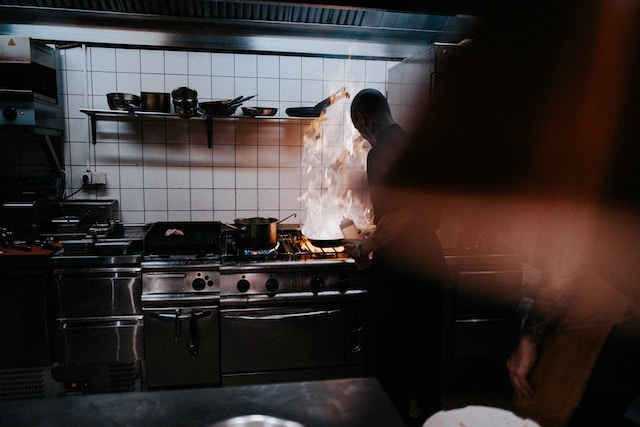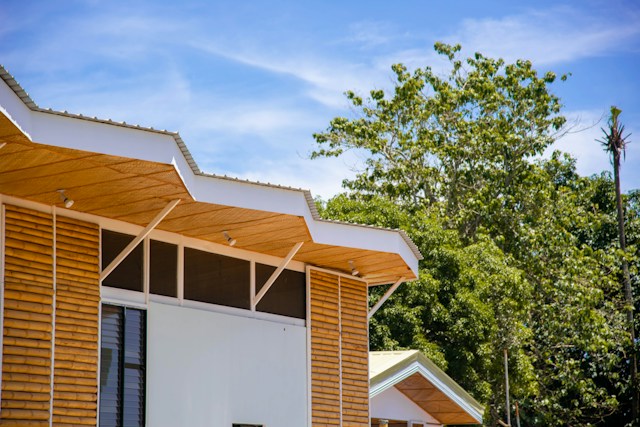In today’s rapidly evolving culinary landscape, the term “ghost kitchen” has become a buzzword in the food industry. The concept of a ghost kitchen, also known as a virtual kitchen or cloud kitchen, has gained immense popularity, revolutionizing the way we think about dining experiences. But what exactly is a ghost kitchen? At its core, a ghost kitchen is a professional food preparation space that operates solely for online orders and delivery, with no dine-in option. It’s the epitome of the modern food business, offering a streamlined and efficient approach to meeting the ever-growing demand for food delivery. And while the idea might initially seem reserved for commercial enterprises, there’s a fascinating trend emerging – the rise of the home-based ghost kitchen. In this article, with the help of the experts, we’ll explore how you can unleash your inner chef and create a successful ghost kitchen right in your own home.
Benefits of opening a ghost kitchen at home
The allure of a home-based ghost kitchen lies in its multitude of benefits. Firstly, it allows passionate home cooks and aspiring chefs to turn their culinary skills into a profitable venture without the high overhead costs associated with traditional restaurants. This means you can embark on your gastronomic journey with relatively low financial risk. Moreover, the flexibility of operating from home enables you to create a personalized and unique dining experience, catering to a niche market or a specific cuisine that resonates with your culinary expertise.
Running a ghost kitchen from home also offers unparalleled convenience. With no need for a brick-and-mortar space, you can save on rent and utility expenses. Additionally, you can maintain a healthier work-life balance by avoiding the grueling hours often associated with traditional restaurants. This setup allows you to focus more on what truly matters – crafting exquisite dishes that tantalize taste buds and keep customers coming back for more.
What are some key benefits of operating a ghost kitchen?
Restaurant owners have had to get inventive and adapt to the new conditions of a post-COVID world to continue in business. Despite the worldwide resurgence of indoor dining, ordering meals online and having them delivered has become increasingly popular. As a result of the increasing demand, ghost kitchens are starting to appear in all the major regions. Moreover, the global ghost kitchen market is anticipated to increase with a CAGR of ~12.1% from 2023 to 2033. Running a ghost kitchen, sometimes called a virtual kitchen, cloud kitchen, or dark kitchen, has many advantages for business owners of restaurants. Some of the benefits include:
- Reduced overhead expenses: Unlike conventional brick-and-mortar restaurants, ghost kitchens often have cheaper starting and ongoing costs. Due to an absence of a real dining area, costs for rent, interior design, and front-of-house personnel are all avoided, resulting in considerable financial savings.
- Increased efficiency: Ghost kitchens are created to maximize output and simplify processes. The company can narrow the focus to preparing and completing delivery orders only, resulting in a more effective workflow and shorter customer wait times.
- Flexibility and experimentation: Without being locked into a long-term contract, ghost kitchens allow for quick testing and iterations of various restaurant concepts and menus. This enables business owners to target particular markets or demographics and respond to shifting culinary trends and preferences.
- Expanded market reach: Ghost kitchens can operate from locations with lower rent, as they don’t require high-visibility storefronts. This allows businesses to serve a wider delivery radius, reaching more customers in different neighborhoods without geographical limitations.
- Less reliance on dine-in business: Traditional restaurants depend heavily on foot traffic and dine-in business. Ghost kitchens prioritize delivery and takeaway, which lessens their reliance on physical locations and increases their adaptability when dine-in options are scarce, such as the covid-19 pandemic.
- Lower carbon footprint: Ghost kitchens are more environmentally friendly than regular restaurants because they mostly serve delivery orders. Optimizing delivery routes may be possible to lower emissions caused by customers traveling to dine-in establishments.
Sneha Varghese at Future Market Insights
Turning your own kitchen into a ghost kitchen

Converting your home kitchen into a ghost kitchen involves several key steps. First and foremost, ensure your kitchen is equipped with the necessary tools and appliances to handle a higher volume of orders. Investing in quality cooking equipment, food processors, and storage solutions will streamline your cooking process and maintain efficiency. To safeguard against unexpected breakdowns that could disrupt your operations, consider having a home warranty for the appliances essential to your ghost kitchen. A home warranty provides valuable peace of mind by covering repair or replacement costs for covered appliances, ensuring that your kitchen remains fully functional and your culinary endeavors continue uninterrupted.
Next, establish a strong online presence. Create a visually appealing website or partner with food delivery platforms to showcase your menu, take orders, and facilitate seamless online transactions. High-quality food photography and well-crafted descriptions are essential to entice potential customers and leave a lasting impression. By combining a well-equipped kitchen with a user-friendly online platform, you’re setting the stage for a successful ghost kitchen venture that caters to the evolving demands of modern diners.
What are the critical steps to establish a successful ghost kitchen business in today’s fast-paced digital age?
In today’s fast-paced digital age, the food industry has witnessed a transformative trend: the rise of ghost kitchens. These innovative culinary concepts have revolutionized restaurant operations, focusing exclusively on online ordering and delivery. To establish a successful ghost kitchen, it’s essential to follow critical steps that align with the ever-evolving needs of your customers. Let’s explore these essential factors that can lead to a thriving ghost kitchen business.
- Identify the right location and cuisine: The appropriate geographical area is crucial for your ghost kitchen’s success. Consider the demographics and preferences of the target audience. Choose a cuisine that suits the local area, or identify a cuisine you’re passionate about and bring it to a new location. This alignment will help you cater to the right audience and establish a strong presence.
- Optimize your kitchen space: Finding an affordable commercial kitchen with easy access for delivery drivers is vital. Avoid long-term contracts initially to retain flexibility. You can efficiently organize your kitchen layout to streamline operations and reduce preparation time. This will allow you to fulfill orders quickly and maintain customer satisfaction.
- Leverage third-party delivery apps: Registering with multiple third-party delivery apps is essential to maximize your visibility and reach a broader audience. These platforms are a gateway to potential customers, so embrace their technology to your advantage.
- Embrace robust technology solutions: Invest in advanced technology that seamlessly manages multiple menus, virtual brands, and order processing within a single system. This integration ensures smooth operations and efficient handling of customer orders.
- Craft compact menus: Focus on creating concise menus for each virtual brand, consisting of up to 10 items. This strategic approach enhances search engine optimization (SEO) on delivery app platforms, making your offerings more visible to potential customers.
- Monitor and adapt: Continuously monitor the performance of your virtual brands and be prepared to replace underperforming ones swiftly. I’d like you to please look over the data and customer feedback to identify areas for improvement and optimize your offerings.
By following these key steps and being responsive to the changing demands of your customers, you can build a thriving ghost kitchen business. Embrace innovation, leverage technology, and stay attuned to consumer preferences. Unleash your inner chef and deliver delightful experiences to your customers through the convenience and efficiency of a ghost kitchen.
Arsen Stepanyan at Orders.co
Running your ghost kitchen

Efficient operations are crucial for the success of your ghost kitchen. Develop a standardized workflow that optimizes order preparation, cooking, and packaging. Time management is key – ensure your dishes can be prepared within a reasonable timeframe to maintain consistency and meet delivery deadlines. Implement effective inventory management practices to minimize wastage and ensure you have all the necessary ingredients readily available.
To enhance customer satisfaction, prioritize packaging. Invest in eco-friendly, durable, and aesthetically pleasing packaging that keeps your dishes fresh during transit. Remember, presentation plays a significant role in shaping your customers’ perception of the overall dining experience.
What are the key operational considerations and best practices for running a successful ghost kitchen?
I suggest working on these business operating principles when creating a Ghost Kitchen. The three priorities are guest satisfaction, quality of product, and cost controls. Don’t lose sight of these.
The predicted consumer demand will help determine if you have a solid business model. You can extrapolate how much revenue you think you can generate based on the demand for the ghost kitchen. Also, review local data on average income, demographics of the local customer base, minors in the household, etc.
Kitchen design plays a significant role in labor efficiency, food quality, and service speed. All are critical for a profitable establishment. Sizing the equipment correctly can save energy costs and supply the needed cooking capacity. It is easy to over-build a kitchen, so be frugal and thoughtful.
Profitability has to be measured so you can make adjustments to meet goals based on the reporting. Efficiency and profitability can be created using tools like a menu mix analysis, labor projection, and estimating controllable expenses. Controlling and measuring costs, so you can continuously improve performance is critical.
Opportunity cost is the value of what you may lose when choosing between two opportunities. So, I would cost out each concept and combine them to compare costs.
Training staff to manage added menu items of the ghost menu is most important. Be careful not to overcomplicate the menu. Err on a smaller menu until you can perfect each item. Have backup menu items that have been developed and cost out. Always have a pipeline of new menu innovation. Be prepared.
Your delivery model needs to be cost-effective, efficient, and high quality, as customer service oriented. It’s all about hospitality.
Charlie Baggs at Charlie Baggs Culinary Innovations
How can integrating a POS system enhance a ghost kitchen’s operational efficiency and overall performance?
Ghost kitchens have zoomed into the superhighway of food delivery, leveraging the might of delivery apps catering to patrons over a conventional restaurant setup. But having killer recipes isn’t enough – they need a solid Point of Sale (POS) system as their co-chef.
Integrating a POS system beefs up performance and fine-tunes efficiency in these spectral kitchens by impacting more than just your appetite. How? It simplifies order processing by gathering requests from diverse platforms onto one user-friendly dashboard. Fewer errors and faster turnarounds rev up kitchen throughput and leave customers with that warm fuzzy feeling–key ingredient for any thriving venture.
What’s hotter or colder on your menu? A trusty POS system keeps an eagle eye over real-time sales data, giving you valuable insight into star dishes and those needing some extra spice. Use this information to sculpt your menu dynamically or target peak hours effectively without breaking a sweat or overstaffing.
Keeping track of grocery shopping is monotonous even at home – imagine doing it for hundreds of meals simultaneously! Thankfully, some POS systems can readily do your inventory checks too. By continuously monitoring ingredient usage per order, they serve fresh updates about stock levels, thereby reducing waste while negating sudden shortages—the secret sauce to cost savings!
Now let’s meet the “front-of-house” benefits: POS systems can improve customer experiences dramatically—even if diners never set foot inside their favorite ghost kitchen! Featuring online bookings, touch-free payment modes, and loyalty programs – every digital interaction wields the power to cement unbreakable bonds with each patron while fostering brand allegiance.
Consider your compelling POS system as less register-cashier-supervisor rolled into one machine; instead, consider it an indispensable sidekick aiding your phantom kitchen to realize its full potential amidst sizzling competition in the food services industry. From boosting operations productivity, spitting out useful business intelligence metrics like daily specials, and meeting stock demands head-on through instant updates about stock availability—to adding satisfying digital-age garnishings on all customer interactions— watch how it helps make the real magic happen round-the-clock in a winning ghost kitchen setup!
Jason Feemster at POS USA
What are the primary benefits of incorporating a POS system into a ghost kitchen’s operations?
Incorporating a Point of Sale (POS) system into a ghost kitchen’s operations can be a game-changer, revolutionizing how these virtual culinary establishments function. Integrating a POS system is a strategic move to amplify efficiency, profitability, and customer satisfaction.
- Streamlined order management: A POS system centralizes order processing, allowing ghost kitchens to manage incoming orders from various online platforms efficiently. This eliminates the need for manual entry and reduces the risk of errors.
- Enhanced inventory management: With a POS system, ghost kitchens can track inventory levels in real time. This ensures that ingredients and supplies are replenished on time, minimizing food wastage.
- Data-driven insights: POS systems gather valuable data on customer preferences, popular dishes, peak ordering times, and more. Ghost kitchens can leverage this information to fine-tune their menus, marketing strategies, and operational hours.
- Efficient workflow: POS systems facilitate a more efficient kitchen workflow. Orders are digitally transmitted to the kitchen staff, reducing the chances of miscommunication. This results in quicker preparation times and ensures customers receive their orders promptly.
- Integrated marketing and loyalty programs: Many POS systems offer integrated marketing features, allowing ghost kitchens to implement loyalty programs, discounts, and promotions seamlessly. These initiatives attract repeat business and create a loyal customer base.
- Financial accuracy: Manual calculations and paper-based transactions can lead to financial discrepancies. A POS system automates the billing process, reducing errors and ensuring accurate revenue tracking.
- Scalability: As ghost kitchens grow and expand, the POS system can scale alongside them. New locations can easily be integrated into the existing system, maintaining consistency and streamlining operations across the board.
- Customer insights: POS systems often allow for tracking customer profiles and order history. This enables personalized service and tailored marketing strategies, creating a more engaging and satisfying customer experience.
By streamlining order management, inventory control, and workflow while also providing insights for better business strategies, a POS system becomes an indispensable tool in the arsenal of a modern ghost kitchen.
Nadiia Shevchuk at Altamira
The importance of marketing

In the digital age, marketing is your most potent tool for reaching a wider audience and establishing a loyal customer base. Leverage social media platforms to showcase your culinary creations, share behind-the-scenes glimpses of your kitchen, and engage with your audience. Engaging content such as cooking tutorials, recipe videos, and chef’s notes can foster a sense of connection and authenticity, making your customers feel like they’re part of your culinary journey.
Collaborate with influencers, food bloggers, and local food critics to generate buzz around your ghost kitchen. Positive reviews and testimonials can significantly impact your reputation and credibility. Additionally, offer promotions, discounts, or loyalty programs to incentivize repeat orders and reward your most loyal patrons.
What are some effective marketing strategies for promoting a ghost kitchen to attract and retain customers?
Marketing is a critical component of operating a ghost kitchen.
While effective marketing strategies are crucial for any food business, it’s even more so for ghost kitchens because they don’t benefit from having a physical venue customers can visit or see.
Taking advantage of efficient marketing and branding practices is vital. Thankfully, online restaurant marketing platforms commonly used by traditional restaurants, like NetWaiter, are also available to ghost kitchens.
Beyond those platforms, social media is the most common place to attract and retain customers for virtual restaurants. Thankfully, social media can help restaurants target specific types of people and turn them into customers with attractive offers and promotions.
Additionally, because many social media platforms are visually oriented, it allows ghost kitchens a good opportunity to market the restaurant’s offerings without a physical location visually.
When investing in social media to attract customers, you should consider the following:
- Using professional photography and videography. Aesthetics is everything – if your food looks good, it’ll sell much better!
- Using professional marketers to help you target the right audience on the right platform.
- Using branding and graphic design that make your brand and your food memorable.
Another opportunity social media creates for ghost kitchens: influencer partnerships.
Partnering with the right influencer can skyrocket sales. For instance, ghost kitchens can use Instagram or TikTok to partner with influencers that are an ideal match for their brand and are willing to promote the virtual restaurant to their followers.
To help retain customers, it’s essential to keep a pulse on the brand’s virtual presence and communicate with guests when things don’t go perfectly.
Because ghost kitchens remove the face-to-face exposure standard among normal restaurants, a customer with a bad experience can’t communicate that feedback in person. This may result in a customer posting a negative review online or griping about their experience on social media. Be sure to address customer complaints quickly and publicly.
NetWaiter
What are some effective social media strategies to boost sales for ghost kitchens?
Ghost Kitchens should prioritize developing a strong brand identity on social media to optimize sales. A cohesive aesthetic that reflects the type of food offered can be achieved using high-quality images and engaging narratives about the business. Utilize social media features like Instagram stories, reels, or TikToks to build a compelling brand story.
Harness the power of targeted advertising available on platforms like Meta & TikTok. Using these tools, you can reach audiences predisposed to your offerings, such as those interested in specific cuisines or frequent users of food delivery apps within your delivery radius. This targeted approach ensures ads reach the most likely potential customers, maximizing return on investment.
Offer exclusive deals via social media to encourage orders. Promotions like special discounts or free add-ons incentivize sales and foster customer loyalty. These deals also motivate social sharing, widening the brand’s visibility.
Maintain active engagement with followers & customers to bolster brand loyalty and cultivate a community. This can be achieved by giving hand-written notes which your order (Which people are more likely to share on their social channels), promptly responding to comments and messages, or sharing user-generated content. This interaction fosters a strong customer connection and facilitates a community feel.
Influencer marketing can also be a potent strategy for brand awareness and customer acquisition. Partner with local influencers with loyal followings, especially micro-influencers in your area. These collaborations can extend your brand’s reach, generate buzz, and offer an authentic promotional angle that resonates with potential customers.
Mark Smith at Double Up Social
What should I consider when choosing a packaging distributor for my ghost kitchen?
When selecting a packaging distributor for your ghost kitchen, it’s essential to evaluate several key factors. First, ensure that the distributor offers eco-friendly and durable packaging options that will maintain the quality of your food during delivery. Additionally, consider their ability to provide customized packaging solutions that reflect your brand identity and enhance customer experience. Lastly, assess their reliability and delivery timelines to ensure you receive your packaging supplies consistently and on time, which is crucial for maintaining efficient operations in a ghost kitchen.
Rick LeBlanc from Reusable Packaging News
In a world where convenience and quality are paramount, the concept of the ghost kitchen has emerged as a groundbreaking solution that empowers culinary enthusiasts to turn their passion into a lucrative business. By transforming your own kitchen into a ghost kitchen, you can capitalize on the benefits of reduced overhead costs, increased flexibility, and a unique dining experience tailored to your expertise.
While the journey to establishing a successful ghost kitchen may be filled with challenges, the rewards are undoubtedly worth it. Embrace your inner chef, experiment with flavors, and embark on a gastronomic adventure that delights the palates of eager diners in the comfort of their homes. With the right mix of culinary prowess, efficient operations, and strategic marketing, you can make your mark in the thriving world of ghost kitchens and leave a lasting legacy on the culinary map. So, unleash your creativity, ignite your burners, and let your culinary dreams take flight – your very own ghost kitchen awaits!




